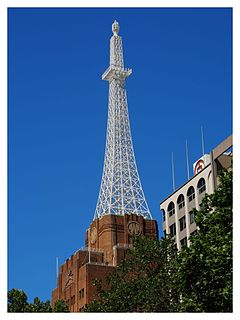
The AWA Tower is a heritage-listed office and communications complex in Sydney, in the state of New South Wales, Australia built for Amalgamated Wireless Australasia Limited. The AWA Tower consists of a radio transmission tower atop a 15-storey building. It is located in the Sydney central business district at 45-47 York Street, close to Wynyard Park and Wynyard railway station. It was designed by Robertson, Marks and McCredie in association with DT Morrow and Gordon and built from 1937 to 1939 by William Hughes and Co. Pty Ltd. It was added to the New South Wales State Heritage Register on 2 April 1999.

The State Savings Bank Building is a heritage-listed large bank building and commercial offices situated at 48-50 Martin Place, in the Sydney central business district in the City of Sydney local government area of New South Wales, Australia. It was designed by Ross & Rowe Architects and Consulting Engineers and built from 1925 to 1928 by Concrete Constructions Ltd. It is also known as The Government Savings Bank of New South Wales, Commonwealth Bank building (former), and CBA Building. After several decades of use by the Commonwealth Bank of Australia, including as its headquarters from 1984, it was purchased by financial services company Macquarie Group in 2012, refurbished, and now serves as Macquarie's global headquarters as 50 Martin Place. It was added to the New South Wales State Heritage Register on 17 November 2000.

Bridge Street is a street in the central business district of Sydney in New South Wales, Australia. Bridge Street runs for 500 metres (1,600 ft) in a west–east direction with traffic flowing in both directions. It is situated in the northern portion of the central business district. The western terminus of Bridge Street is at George Street, with the eastern terminus at Macquarie Street, adjacent to the Chief Secretary's Building. From west to east, Bridge Street crosses Pitt and Phillip streets.

Wilhemsen House, also known as the Elders Building, Elder Building, Barwil House and the Dalgety & Co. Building, is a heritage building located at 11 Cliff Street on the corner of Phillimore Street in the port city of Fremantle, Western Australia. The building dates from the gold rush boom period in the late nineteenth and early twentieth centuries and is of historic significance.

The GIO Building is a heritage-listed office tower located at 60-70 Elizabeth Street in the Sydney central business district in the City of Sydney local government area of New South Wales, Australia. It was built during 1929. It is also known as the General Insurance Office Building; the GIO building, and was constructed as the Sun Building or the Sun Newspaper Building. The property is privately owned and was added to the New South Wales State Heritage Register on 2 April 1999.

Newcastle Post Office is a heritage-listed former post office at 96 Hunter Street, Newcastle, City of Newcastle, New South Wales, Australia. It was designed by Walter Liberty Vernon in his capacity as New South Wales Government Architect and was built from 1900 to 1903 by R. Saunders (freestone), Loveridge & Hudson (trachyte), Mountney & Co., Chas Dobson & Co. and J. P. Woods. It was added to the New South Wales State Heritage Register on 22 December 2000.

The Tamworth Post Office is a heritage-listed post office located at Fitzroy Street, Tamworth in the Tamworth Regional Council local government area of New South Wales, Australia. It was designed by the Colonial Architect's Office under James Barnet and built by W. C. Cains. The property is owned by Australia Post and was added to the New South Wales State Heritage Register on 22 December 2000.

The Greenway Wing of the Supreme Court of New South Wales is a heritage-listed courthouse located at the junction of King and Elizabeth Streets, in the Sydney central business district, in the City of Sydney local government area of New South Wales, Australia. It was designed by Francis Greenway, Standish Lawrence Harris, and James Barnet and built from 1820 to 1828. It is also known as Sydney Supreme Court House and Old Court House. The property is owned by the Department of Justice and Attorney General, departments of the Government of New South Wales. It was added to the New South Wales State Heritage Register on 2 April 1999.

The North Sydney Post Office is a heritage-listed post office located at 92-94 Pacific Highway, North Sydney, North Sydney Council, New South Wales, Australia. It was designed by the Colonial Architect’s Office under the direction of James Barnet, and built from 1885 to 1889 by James Reynolds. The property is owned by Australia Post, an agency of the Australian Government. It was added to the New South Wales State Heritage Register on 22 December 2000.

The Model Factory and Dwelling is a heritage-listed former factory, store and dwelling and now offices located at 120 Gloucester Street in the inner city Sydney suburb of The Rocks in the City of Sydney local government area of New South Wales, Australia. It was designed by George McRae and built from 1912 to 1913. It is also known as Chung Lun Building and (erroneously) the Housing Board Building. The property is owned by Property NSW, an agency of the Government of New South Wales. It was added to the New South Wales State Heritage Register on 10 May 2002.

Science House is a heritage-listed commercial building located at 157–169 Gloucester Street and Essex Street, in the inner city Sydney suburb of The Rocks in the City of Sydney local government area of New South Wales, Australia. It was designed by Peddle Thorp & Walker Architects and built in 1930 by John Grant and Sons, Master Builders. It was also known as Sports House from 1978–1991. The property is owned by Property NSW, an agency of the Government of New South Wales. It was added to the New South Wales State Heritage Register on 10 May 2002.
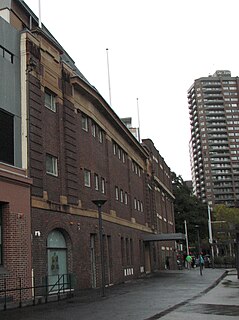
Lawson House is a heritage-listed warehouse, auction house and offices located at 212-218 Cumberland Street, in the inner city Sydney suburb of The Rocks in the City of Sydney local government area of New South Wales, Australia. It was designed by John Burcham Clamp and built during 1924 by Burcham Clamp and Finch. It is also known as Cadbury-Fry Building and Lawson Menzies Building. The property is owned by Property NSW, an agency of the Government of New South Wales. It was added to the New South Wales State Heritage Register on 10 May 2002.
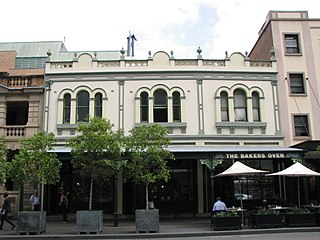
123-125 George Street, The Rocks are heritage-listed shops and former residence located at 123-125 George Street, in the inner city Sydney suburb of The Rocks in the City of Sydney local government area of New South Wales, Australia. It was built for Thomas Playfair during 1882. The property is owned by Property NSW, an agency of the Government of New South Wales. It was added to the New South Wales State Heritage Register on 10 May 2002.
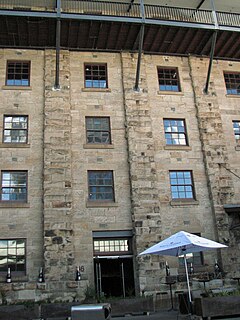
The MSB Stores Complex is a heritage-listed former warehouse and gas manufacturing plant and now offices and storage located at 2-4 Jenkins Street, in the inner city Sydney suburb of Millers Point in the City of Sydney local government area of New South Wales, Australia. It was built from 1844. It is also known as Maritime Services Board Office and Store and Australian Gas Light Company Stores and Offices. It was added to the New South Wales State Heritage Register on 18 April 2000.

The Corn Exchange is a heritage-listed former market building located at 173-185 Sussex Street, in the Sydney central business district, in the City of Sydney local government area of New South Wales, Australia. It was designed by George McRae and built from 1887. It formerly housed PACT Youth Theatre. It was incorporated into the Nikko Hotel development in the 1980s, but has been commercial office space since the 1990s. It was added to the New South Wales State Heritage Register on 28 June 2002.

107-109 Bathurst Street, Sydney is a heritage-listed former bank building and now KFC fast food restaurant located at 107-109 Bathurst Street in the Sydney central business district, in the City of Sydney local government area of New South Wales, Australia. The property is privately owned. It was added to the New South Wales State Heritage Register on 2 April 1999.

Wales House is a heritage-listed former newspaper office building, bank building and now hotel located at 64-66 Pitt Street, in the Sydney central business district, in the City of Sydney local government area of New South Wales, Australia. It was designed by Manson & Pickering and built from 1922 to 1929 by Stuart Bros. It is also known as the Bank of NSW Building. The property is owned by Wales House Nominees Pty Ltd. It was added to the New South Wales State Heritage Register on 2 April 1999. Located on the junction of Pitt, Hunter and O'Connell Streets, the building served as offices for John Fairfax and Sons' The Sydney Morning Herald from 1927 to 1955 before being acquired by the Bank of New South Wales, commonly known as "The Wales", hence the building's name. The building has subsequently been converted into an international hotel, as part of the Radisson Blu hotel chain.
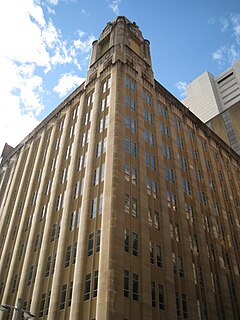
The MLC Building is a heritage-listed office building located at 42-46 Martin Place in the Sydney central business district, in the City of Sydney local government area of New South Wales, Australia. It was designed by Bates Smart & McCutcheon and built from 1936 to 1938 by Concrete Constructions Limited. It is also known as Mutual Life & Assurance Building. It was added to the New South Wales State Heritage Register on 2 April 1999. From the time of its construction and for many years thereafter, the building served as the offices for Australian life insurance company, Mutual Life & Citizens Assurance Company Limited. As of December 2018 the anchor tenant was Norton Rose Fulbright, formerly Henry Davis York, an international law firm.

Grahame's Corner is a heritage-listed commercial and office building located at 142-144 Pitt Street, in the Sydney central business district, in the City of Sydney local government area of New South Wales, Australia. It was designed by G. A. Morell and built from 1877 to 1882. It is also known as Grahams Corner and the AMFIS Building. The property was added to the New South Wales State Heritage Register on 2 April 1999.

354 George Street, Sydney is a heritage-listed retail and office building and former bank building located at 354 George Street, in the Sydney central business district, in the City of Sydney local government area of New South Wales, Australia. It was designed in various stages by Edward Raht, A. K. Henderson, Joseland & Gilling and Kevin Winterbottom and Assoc. and built in various stages from 1902 to 1937 by Loveridge & Hudson and Kell & Rigby. It is also known as ANZ Bank (former); ANZ Bank; United Permanent Building; 2 Martin Place; Paspaley Pearls; 354-360 George Street; and Bank of Australasia. The property is owned by Paspaley Pearls Properties P/L. It was added to the New South Wales State Heritage Register on 2 April 1999.





















